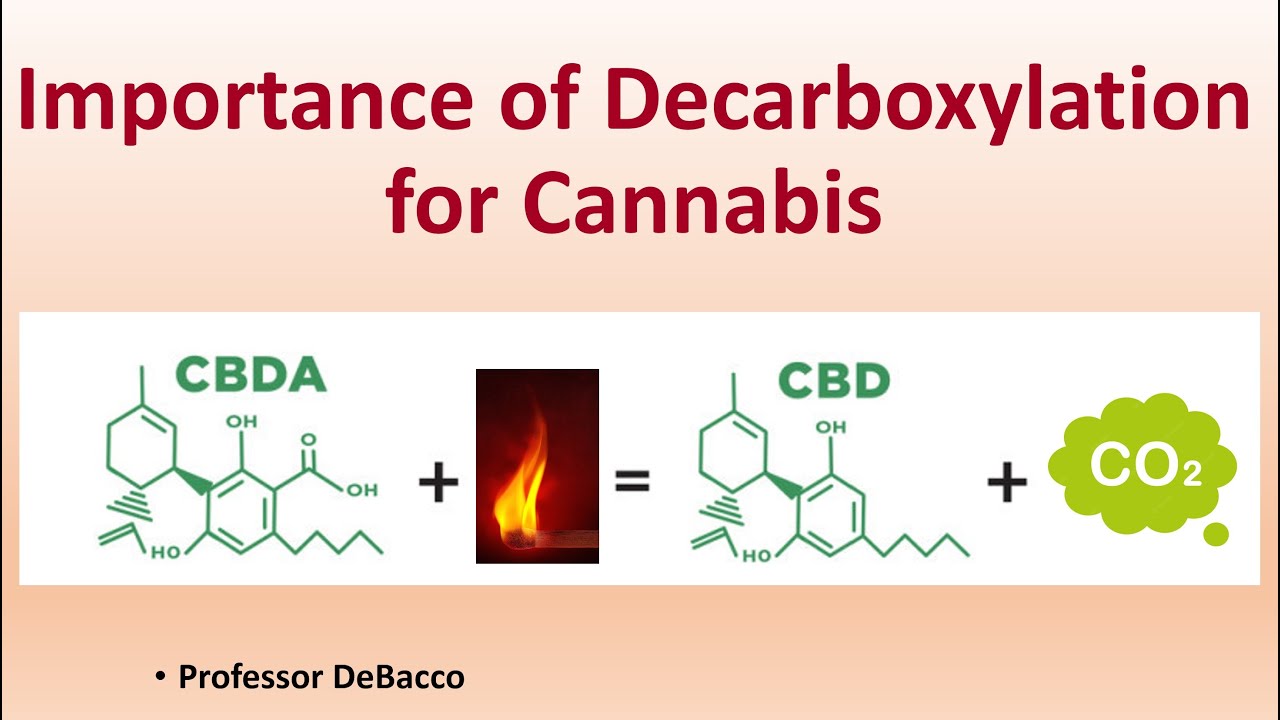Importance of Decarboxylation for Cannabis
Professor DeBacco
Research Article
ALEKSANDROV, M., & JANEVIK IVANOVSKA, E. (2022). THE ROLE AND IMPORTANCE OF THE DECARBOXYLATION PROCESS IN THE PRODUCTION OF QUALITY FULL-SPECTRUM CANNABIS EXTRACT FOR MEDICINAL PURPOSES. International Journal of Medical Sciences, 7(13-14), 119-128.
https://eprints.unite.edu.mk/963/
What is Decarboxylation?
All cannabinoids contained within the trichomes of raw cannabis flowers consists of cannabinoids in their acidic form and have an extra carboxyl ring or group (-COOH) attached to their chain.
Decarboxylation (or “decarbing”) is where raw cannabis is heated so that the chemical structure of the acid cannabinoids changes to a neutral (non-acid) form.
Acidic to Neutral Form Conversion
When one states that cannabinoids are in their “acidic form”, they are referring to the chemical structure of the compound itself.
A cannabinoid in its acidic form has a carboxyl group (-COOH) attached and the neutral forms, will have this carboxyl group removed.
Acid = Raw plant material
Neutral = Decarboxylated compound
Chemical Structure Changes
Transforming cannabinoid acids into their neutral forms, need to remove the carboxyl group.
The weak bond holding the carboxyl group can be broken by a combination of heat and time.
Why Does Cannabis need Carboxylation?
This process essentially converts the chemicals into an “active” form by increasing the bodies ability to absorb and bind to the molecules.
Essentially the body can use the “active” form.
Carboxylation happens naturally when the plant material is ignited.
Importance of Decarboxylation: THCA vs THC
While THCA is the non-psychoactive (not decarboxylated form) precursor to THC (the decarboxylated form), it does not bind to the CB1 and CB2 receptors.
Note: THCA binds with other cannabinoids receptors in the endocannabinoid system.
Although THCA possesses therapeutic effects, like anti-inflammatory and neuroprotective qualities, it is not in its most beneficial or psychoactive form.
Decarboxylation Requires Heat and Time
The two main catalysts for decarboxylation to occur are heat and time.
Drying and curing cannabis over time will cause partial decarboxylation to occur.
While heat is needed to decarboxylate the acids into the active form of cannabinoids our bodies can use, extreme temperatures can destroy many of the important plant materials that contribute to positive health outcomes, like terpenes.
Use Minimal Temperature to Preserve Terpenes
Cannabis Trim
Trim is what is removed from the final flower after harvest.
Trim includes sugar leaves, bits of cut-off buds, and knocked off trichomes, or kief.
Kief Explained
When trichomes dry and break off of the plant, they become kief.
Kief, because it has oxidized and loses its freshness when separated from the plant buds, usually has a darker color than trichomes, ranging from light gold to brown.
It has a powdery appearance and a texture that is somewhat sticky, though less so than trichomes on a bud.
Kief tends to decarb faster than an intact flower.
Other Factors of Variability…
Variety of Cannabis Used
Each type of cannabis contains different amounts and ratios of different cannabinoids and terpenes which impact the optimum decarboxylation time and temperatures.
This can also be impacted by the physical structure of the flower
Age (Freshness) of Product
There will be noticeable differences in the final product depending on the age (freshness) of the material you start with.
Remember: The decarboxylation process only converts the acidic form to the bioactive neutral form, it does not “create” the CBD or THC molecule.
Equipment Being Used
Reducing the variability and the ability to maintain a precise temperature will have a direct impact on the total yield.
This is why a equipment intended for this purpose is recommended such as a Decarboxylation Jacketed Glass Reactor or a professional oven.
Flower Uniformity
This can refer to the size and also the density of the final flower.
If the flower consistency is widely variable grinding up the plant material will increase the uniformity of the decarboxylation process.
General Key Points
Need to have in mind that, at higher temperatures, Kief and Hash tend to decarboxylate faster than dried flowers.
High CBD strains tend to decarboxylate a bit slower than those with high THC content
Three Main Decarboxylating Factors for Cannabis
The most important parameters to perform a good decarboxylation process are…
Time (duration)
Temperature
Quality decarboxylation equipment
Suggestions for Decarboxylating Your Cannabis
From the review of published literature data…
Highest concentration of THC (about 15 mg/g) is obtained when the material is decarboxylated at 122°C for 27 minutes.
Converting CBDA to CBD, a higher temperature is required, about 150°C, for about 30 minutes.
To decarboxylate Kief or Hash in an oven, bake it for 10 minutes at 300°F (149°C).
source



